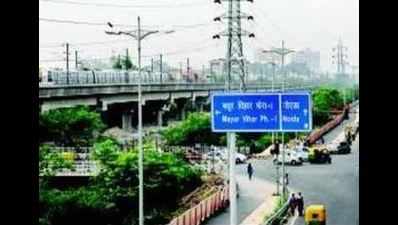- News
- City News
- delhi News
- Delhi: Mayur Vihar-Lajpat Nagar link will bring east, south closer
Trending
This story is from September 15, 2018
Delhi: Mayur Vihar-Lajpat Nagar link will bring east, south closer
Areas in the heart of south Delhi such as Moti Bagh, Sarojini Nagar, South Extension, Lajpat Nagar and Ashram will get direct connectivity with east Delhi when the 9.7-km section of the Delhi Metro’s Pink Line between Lajpat Nagar and Mayur Vihar Pocket 1 starts operating

Representative image.
Key Highlights
- The Mayur Vihar-I station will then become an interchange station, connecting the Pink Line (Majlis Park-Shiv Vihar) with the Blue Line (Noida City Centre/Vaishali-Dwarka).
- Along with Anand Vihar, Karkardooma and Welcome stations of the Pink Line, Mayur Vihar-I will be a major hub in east Delhi, connecting south Delhi and facilitating travel to east Delhi areas.
NEW DELHI: Come November, and south Delhi will be less than 15 minutes away from east Delhi and the distance between south Delhi and Noida will also shrink. Areas in the heart of south Delhi such as Moti Bagh, Sarojini Nagar, South Extension, Lajpat Nagar and Ashram will get direct connectivity with east Delhi when the 9.7-km section of the Delhi Metro’s Pink Line between Lajpat Nagar and Mayur Vihar Pocket 1 starts operating.Trial runs have already started for an expected opening in November.

The Mayur Vihar-I station will then become an interchange station, connecting the Pink Line (Majlis Park-Shiv Vihar) with the Blue Line (Noida City Centre/Vaishali-Dwarka). Along with Anand Vihar, Karkardooma and Welcome stations of the Pink Line, Mayur Vihar-I will be a major hub in east Delhi, connecting south Delhi and facilitating travel to east Delhi areas such as Laxmi Nagar, Preet Vihar and Anand Vihar and further to Vaishali in Ghaziabad via the Blue Line.
Commuters will be able to take a train to Noida City Centre from the Blue Line station instead of taking a long detour through Rajiv Chowk or Mandi House, the current interchange. After the Magenta Line (Botanical Garden-Janakpuri West), the Pink Line will provide an alternative travel route between south Delhi and Noida. The new section will also make it easier for east Delhi residents to reach Hazrat Nizamuddin railway station and Sarai Kale Khan Inter-State Bus Terminal, which don’t have any metro connectivity at present.
DMRC faced many engineering challenges when constructing the Pink Line Mayur Vihar I station because it had to contend with not only the existing Blue Line corridor but also the Delhi-Noida Link Road flyover and the Barapullah elevated corridor. Consequently, this station is built at a height of 22 metres, 10 metres higher than the Blue Line station. The two stations are connected by a 63-metre footbridge.
DMRC designed special pillars to support the structure as there was not enough space to erect more pillars. Due to the space crunch, DMRC also moved the control rooms and other ancillary units to a separate building next to the station. Due to the height difference between the two stations, DMRC has built a mezzanine floor in the newer one to allow easy travel between the two.
The section from Lajpat Nagar to Mayur Vihar I consists of five stations: Vinoba Puri, Ashram, Hazrat Nizamuddin, Mayur Vihar-I and Mayur Vihar Pocket-I. Of the five stations, Mayur Vihar-I and Mayur Vihar Pocket-I are elevated station, the rest being underground.

The Mayur Vihar-I station will then become an interchange station, connecting the Pink Line (Majlis Park-Shiv Vihar) with the Blue Line (Noida City Centre/Vaishali-Dwarka). Along with Anand Vihar, Karkardooma and Welcome stations of the Pink Line, Mayur Vihar-I will be a major hub in east Delhi, connecting south Delhi and facilitating travel to east Delhi areas such as Laxmi Nagar, Preet Vihar and Anand Vihar and further to Vaishali in Ghaziabad via the Blue Line.
Commuters will be able to take a train to Noida City Centre from the Blue Line station instead of taking a long detour through Rajiv Chowk or Mandi House, the current interchange. After the Magenta Line (Botanical Garden-Janakpuri West), the Pink Line will provide an alternative travel route between south Delhi and Noida. The new section will also make it easier for east Delhi residents to reach Hazrat Nizamuddin railway station and Sarai Kale Khan Inter-State Bus Terminal, which don’t have any metro connectivity at present.
The Mayur Vihar-I station is currently used by around 30,000 people, and once it becomes an interchange station, the Delhi Metro Rail Corporation (DMRC) expects the figure to rise to one lakh. It is unique in more ways than one, including the distinction of being a station at the longest distance from the next station — Hazrat Nizamuddin metro station. The distance between the two, which includes bridging the Yamuna, is one of the longest in the Delhi Metro network and the fourth crossing of the river.
DMRC faced many engineering challenges when constructing the Pink Line Mayur Vihar I station because it had to contend with not only the existing Blue Line corridor but also the Delhi-Noida Link Road flyover and the Barapullah elevated corridor. Consequently, this station is built at a height of 22 metres, 10 metres higher than the Blue Line station. The two stations are connected by a 63-metre footbridge.
DMRC designed special pillars to support the structure as there was not enough space to erect more pillars. Due to the space crunch, DMRC also moved the control rooms and other ancillary units to a separate building next to the station. Due to the height difference between the two stations, DMRC has built a mezzanine floor in the newer one to allow easy travel between the two.
The section from Lajpat Nagar to Mayur Vihar I consists of five stations: Vinoba Puri, Ashram, Hazrat Nizamuddin, Mayur Vihar-I and Mayur Vihar Pocket-I. Of the five stations, Mayur Vihar-I and Mayur Vihar Pocket-I are elevated station, the rest being underground.
End of Article
FOLLOW US ON SOCIAL MEDIA










